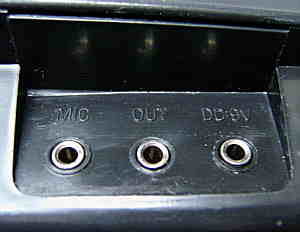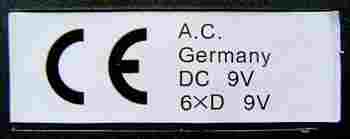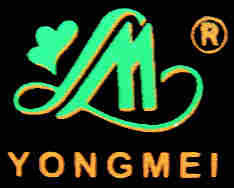 |
 |
| squarewave tablehooter
with unique percussion |
|
This extremely rare squarewave tablehooter is based on an odd monophonic
variant of Hing Hon EK-001 sound
generator. Interesting is that the preset sounds and the great impulsive
POKEY percussion timbres are different. Unfortunately the instrument is
detuned by 5 full notes(!) and the plastic is terribly fragile. Also the
leftmost 2 keys and the 5th drumpad are fake.
Regarding the cable mess inside, this shanzhai
keyboard was likely a direct predecessor of the MeiKe
MK-320B. In opposite to this it has a sustain button, a simple
record/ playback sequencer, 12 demos and a slide switch that muffles the
main voice. The 3 step volume slide switch can not be set really low, but
unlike older Yongmeis it is at least sufficient not to hurt your ears.
warning: Never send a keyboard with this case through mail without
multiple centimeters(!) of padding (styrofoam, firmly crushed paper, fanfolded
cardboard or similar), because the plastic is brittle like glass and will
unavoidably shatter into a zillion of pieces as soon they toss it around
in the mail. (Older Yongmei keyboards original packaging contains no end
padding at all and thus is absolutely unsuited(!) for mail shipping.)
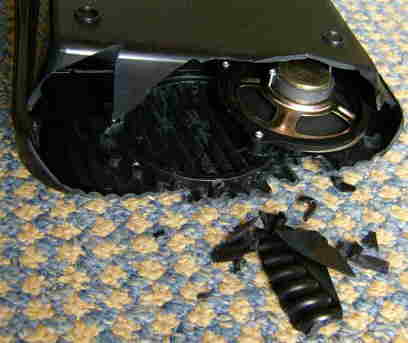 My
Yongmei MS-210B arrived with its right end smashed to about 30 small debris
because the vendor didn't pad the case end properly but despite warning
only wrapped the original box in a thin layer of bubble wrap, which is
in no way sufficient. A year before that I had ordered a MS-110A
with identical case, that was shattered similarly, but when I reported
that damage in a Deutsche Post post office, the spirt- nosed post
office clerk smeared a few words across the damage report form (instead
of filling out the entries), intentionally smashed the remains of the wrapped
keyboard with a huge 20kg parcel on a trolley and sent it back to the sender
despite I explicitly requested to sent it back to me after damage analysis.
I never saw that keyboard again nor I got any money back. Thus I did not
report the incident with the shattered MS-210B to a post office again,
but puzzled it together with a lot of superglue, which took a full day. My
Yongmei MS-210B arrived with its right end smashed to about 30 small debris
because the vendor didn't pad the case end properly but despite warning
only wrapped the original box in a thin layer of bubble wrap, which is
in no way sufficient. A year before that I had ordered a MS-110A
with identical case, that was shattered similarly, but when I reported
that damage in a Deutsche Post post office, the spirt- nosed post
office clerk smeared a few words across the damage report form (instead
of filling out the entries), intentionally smashed the remains of the wrapped
keyboard with a huge 20kg parcel on a trolley and sent it back to the sender
despite I explicitly requested to sent it back to me after damage analysis.
I never saw that keyboard again nor I got any money back. Thus I did not
report the incident with the shattered MS-210B to a post office again,
but puzzled it together with a lot of superglue, which took a full day. |
The case style of the MS-210B still looks very much like a Yongmei transistor
tooter (see Golden Camel-7A) despite
it already contains digital hardware. Interesting is that the letters "MS-"
on the control panel here suggests the abbreviation "Musical Source", while
they normally are associated with Miles, MeiKe, Meiker
or the genuine name of the manufactures Meisheng. Like with other Yongmeis,
also here the manual contains a lot of false claims, and this one is especially
ridiculous, thus I quote it here since the text proudly advertises this
tablehooter in the style of earliest 1980th ads for a Roland TB-303
("computer controlled"...) or similar:
| Thank you for purchasing MS-210B Luxury Computed Electronic Keyboard.
Wish you to enjoy yourself with MS-210B and have a wonderful time forever.
MS-210B is a portable instrument with varieties of beautiful tones.
Its multifunction is flexible and easy to operate. The following are the
features:
-
Multiple Realistic Tone Quality
With noise absorbing circuit, sustaining circuit, and dual channels
of tone generator*, the MS-210B provides you
with accurate pitch**, beautiful tone quality,
sustain, vibrato, and excellent stereo effect***.
There are 8 different instruments and 4 kinds of percussion.
[...]
-
Record/Playback/Autostop
The MS-210B can record 62 notes and can playback. If the keys are not
touched within 5 minutes, the power of the computer will stop automatically.
|
*) In fact it is completely monophonic.
**) It is genuinely detuned by 5 full notes (i.e. 500 cent; 'C' is on 'G')
instead of having "Tone Quality < 3CENTS"
like claimed in its feature list. ***) In reality the amplifier is completely
mono.
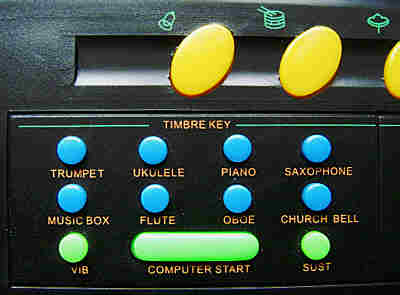 There
is a big button with the fancy name "computer start" and 12 white keys
are marked with cryptic looking green letters (which awakes memories to
the great age of of Casio's early 1980th keyboards). Unfortunately
this mysterious button turns out to be only the standby on/off switch,
which needs to be pressed additionally to the normal power switch to turn
the instrument on, and the standby not even turns off the internal amplifier,
which voids the wannabe auto-power-off feature of the "computer" to save
batteries. The manual also mentions a mysterious "Encircled Sound" button,
which in fact seems to be the 3rd slide switch which simply makes the main
voice duller by a capacitor. (I could imagine that the name "Encircled
Sound" was genuinely the Chinese to Engrish translation for stereo
chorus - a feature that would make no sense in a mono keyboard anyway.) There
is a big button with the fancy name "computer start" and 12 white keys
are marked with cryptic looking green letters (which awakes memories to
the great age of of Casio's early 1980th keyboards). Unfortunately
this mysterious button turns out to be only the standby on/off switch,
which needs to be pressed additionally to the normal power switch to turn
the instrument on, and the standby not even turns off the internal amplifier,
which voids the wannabe auto-power-off feature of the "computer" to save
batteries. The manual also mentions a mysterious "Encircled Sound" button,
which in fact seems to be the 3rd slide switch which simply makes the main
voice duller by a capacitor. (I could imagine that the name "Encircled
Sound" was genuinely the Chinese to Engrish translation for stereo
chorus - a feature that would make no sense in a mono keyboard anyway.) |
main features:
-
42 midsize keys + 2 fake keys for one key play
-
2 built-in speakers (mono)
-
monophonic main voice
-
8 OBS preset sounds {trumpet, ukulele, piano, saxophone, music box, flute,
oboe, church bell}
-
8 OBS preset rhythms {ballad, 8 beat, rock, chacha, waltz, beguine, swing,
march} with unique percussion
-
master volume slide switch (3 steps)
-
tempo +/- buttons (16 steps)
-
muffle slide switch (mislabelled "sustain")
-
vibrato & sustain button (vibrato modulates CPU clock)
-
4 drumpad buttons {bell, base, snare, hihat} (wrong icons show {bell, snare,
open hihat, close hihat}, fake 5th button starts demos)
-
sound generator like Hing Hon EK-001,
but with only monophonic main voice and different percussion. The piano
sound ignores key press duration.
-
percussion {bell, base, snare, hihat} resembling Hing
Hon EK-001 (great impulsive POKEY blip sounds).
-
CPU= "210" (named "FE-2"
in schematics, 32 pin COB)
-
simple sequencer (monophonic record/ playback of 62 notes, no edit, with
one key play)
-
12 demo melodies (monophonic with standard rhythms)
-
partial auto- power off (doesn't turn off the amplifier)
-
jacks for microphone, headphone & AC- adapter
eastereggs:
-
Like in Hing Hon EK-001, when multiple
sound buttons are held down simultaneously, the CPU switches quickly between
the selected sounds, resulting in a rough and buzzy kind of fast arpeggiator
effect (like known from C64 SID musics). Most of the resulting sounds are
relatively disharmonious, but they are unique and sound quite massive.
(In unmodified state some of these button combinations mess up the keyboard
matrix and though cause undesired side effects like disturbing drum pads
etc.)
-
Holding 'waltz' together with any other preset rhythm button produces rhythm
variations.
-
The standby button ("computer start") can be used to chop the main voice,
because decaying notes continue to decay after powering on again (the envelope
capacitor keeps its charge).
-
Switching power off makes held notes howl down.
notes:
The operation of the 5 slide switches is very confusing because they are
totally mislabelled. Switch 1 is the power switch. Switch enables the 2
leftmost fake keys for one key play (when off, they do nothing). Switch
3 makes the main voice duller (using a capacitor). Also switch 4 seems
to make the sound a tiny bit duller (it has a resistor to the amp), but
only when switch 3 is on. Switch 5 is the 3 step master volume control.
Very annoying is that the main voice is detuned by 5 full notes, which
can be fixed by changing the CPU clock resistor.
The preset sounds employ the same multipulse squarewave sound generator
with capacitor envelope like Hing Hon EK-001,
but the timbres are programmed differently. The continuous tones (like
flute) have all a slow attack phase and contain all at least 1 second of
sustain (like a pipe organ). The sustain button adds a long 3 seconds sustain
(or disables it where enabled) and the vibrato button adds a 6Hz vibrato.
The 'trumpet' has enabled sustain (3 seconds) and sounds rather like a
bright metal pipe organ rank. The 'ukulele' has a buzzy harsh timbre with
8Hz mandolin ring. The 'piano' has enabled sustain and ignores key press
duration. The 'saxophone' resembles 'organ' on EK-001 (the classic sonorous
multipulse squarewave pipe organ timbre with enabled sustain) but drones
less impressive. 'music box' and 'flute' sounds like intended. 'oboe' resembles
'violin' on EK-001 (another sonorous multipulse timbre). 'church bell'
is a metallic multipulse timbre with sustain.
The percussion has the same wonderful impulsive POKEY style like in
EK-001,
but the sounds are slightly different. The 'bell' is a little lower, the
'base' is a little lower and decays faster, the 'snare' is more impulsive
and decays much faster (i.e. more realistic). The closed hihat is the same
and also most rhythms of the MS-210B are the same; many are simply renamed.
The 'rock' corresponds to 'pop' on EK-001, '8 beat' to 'disco', 'beguine'
to 'rhumba'. Only 'chacha' replaces here 'tango'.
The primitive sequencer is always in record mode and records all notes
until it runs out of memory. The recording can be played back with "playback"
button or note by note with the leftmost 2 fake piano keys (labelled "RECORD
TEST"). To enable these keys, the 2nd slide switch must be in the "on"
position. Although the sequencer is fairly useless since played notes always
append to its contents, it is impressive that it does not interfere at
all with rhythms, thus you can start, stop and change rhythm or tempo without
any effect on the playing sequence. The tempo setting has no effect on
the playback speed.
| The demo musics of this instrument are monophonic with standard rhythm.
The demos are started by pressing the rightmost fake drumpad button (which
turns off the green power LED). Other demos can be selected through 12
of the white keyboard keys those are marked with green letters. A little
funny is that written over 2 adjacent of these keys stands here "DEMONSTR
| ATE SONGS". When I read it first, I though: "Huh, what demon monster
ate songs?!". ;-) |
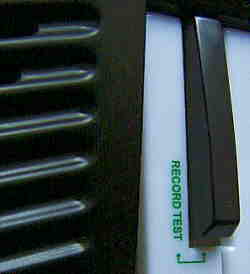 |
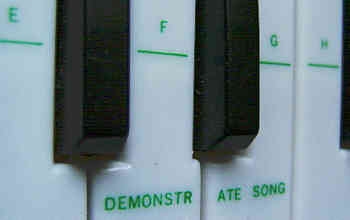 |
hardware details
The Yongmei MS-210B is based on the CPU "210"
(32 pin COB version of Holtek HT3421A).
Like with the old Yongmei transistor tooters (see Golden
Camel-7A), the botched hardware contains horrible cable mess; the
switch contacts are of sheet metal scratching on bare copper PCB traces,
and also the key contacts employ such leaf switches. At least there are
polarity protection diodes to prevent battery explosion during mains operation.
The mono amplifier PCB looks like in MeiKe
MK-320B.
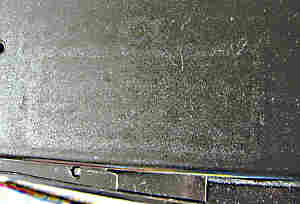
Apparently the batteries were early planned to the right, |
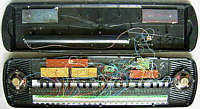
a lot of cable mess inside,... |
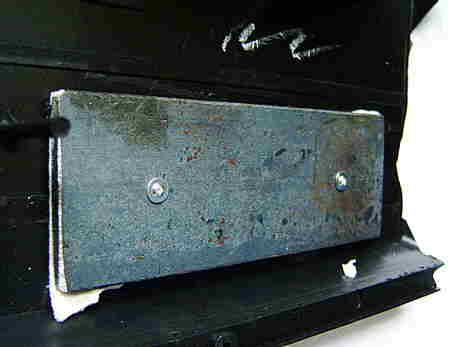
and what the fuck - an iron weight! |
Most bizarre is that the lightweight plastic case of this Ming vase is
weighted by 2 thick iron bar weights, those serve no other purpose than
making it even more fragile during shipping, and if roughly handled with
6 heavy D cells inside, for sure will turn into ball breakers those shatter
everything to shards.
The CPU "210" (32 pin COB)
is a software variant of the PHW635
found in PlaySkool PS-635. Only
preset sounds, preset rhythms and demo songs were changed, but behaviour
stays the same.
multipulse squarewave tone generator
The main voice sound generator is the same like in PlaySkool
PS-635 but the preset sounds differ. Technically this is a monophonic
variant of the Hing Hon EK-001
sound engine. Some multipulses have a strange dot (short dropout to lo)
in their hi section. I expect this artifact to be caused by restarting
the address counter at the begin of the loop point. Thus I have visually
rotated these patterns to shift the dot (marked ".") to their end. (Other
multipulses likely have it at a lo section, where it stays invisible.)
Internally all multipulses are 16 step long; for readability I have omitted
repeating parts. The 'ukulele' contains mandolin ring, but unlike the PS-635
and EK-001 'mandolin' it is not made from plain squarewave. The 'music
box' is here even 2 instead of 1 octave higher (i.e. the likely highest
pitch this sound engine can produce if step rate is fixed). The metallic
'church bell' timbre strongly differs from other variants with this sound
engine.
The multipulse bit loops look like this:
| preset sound |
multipulse pattern |
comment |
| piano |
1111111100001011. |
(same like 'guitar' in PS-635) |
| oboe |
1010101000110011. |
|
| ukulele |
1001010001110001. |
|
| flute |
11110000 |
plain squarewave |
| trumpet |
11100100 |
|
| saxophone |
1000110110010101. |
|
| music box |
10 |
plain squarewave (2 octaves higher) |
| church bell |
1011001001001101. |
|
keyboard matrix
The keyboard matrix corresponds to PlaySkool
PS-635, but sound and rhythm names differ. This matrix is based
on the MS-210B schematics any my own
examination. Beside separate rhythm start & -stop buttons I found no
eastereggs, but here is it for comparison.
|
17 C1
|
16 C2
|
15 C3
|
14 C4
|
13 C5
|
12 C6
|
11 C7
|
|
CPU pin
|
|
out 1
|
out 2
|
out 3
|
out 4
|
out 5
|
out 6
|
out 7
|
in / out
|
|
o
C#5
|
o
C#4
|
o
C#3
|
P.
base
|
tempo
+
|
O.
piano
|
R.
chacha
|
in 1
|
18 R1
|
o
D5
|
o
D4
|
o
D3
|
P.
cowbell
|
tempo
-
|
O.
oboe
|
R.
march
|
in 2
|
19 R2
|
o
D#5
|
o
D#4
|
o
D#3
|
P.
snare
|
R.
start
|
O.
ukulele
|
R.
rock
|
in 3
|
20 R3
|
o
E5
|
o
E4
|
o
E3
|
P.
hihat
|
R.
start/stop
|
O.
flute
|
R.
swing
|
in 4
|
21 R4
|
o
F5
|
o
F4
|
o
F3
|
-
|
R.
stop
|
O.
trumpet
|
R.
8 beat
|
in 5
|
22 R5
|
o
F#5
|
o
F#4
|
o
F#3
|
-
|
demo
|
O.
saxophone
|
R.
beguine
|
in 6
|
23 R6
|
o
G5
|
o
G4
|
o
G3 (1)
|
o
G2
|
vibrato
|
O.
musicbox
|
R.
ballad
|
in 7
|
24 R7
|
o
G#5
|
o
G#4
|
o
G#3
|
o
G#2
|
sustain
|
O.
church bell
|
R.
waltz
|
in 8
|
25 R8
|
o
A5
|
o
A4
|
o
A3
|
o
A2
|
S.
clear
|
O.
piano
|
R.
chacha
|
in 9
|
26 R9
|
o
A#5
|
o
A#4
|
o
A#3
|
o
A#2
|
S.
play
|
O.
oboe
|
R.
march
|
in 10
|
27 R10
|
o
B5
|
o
B4
|
o
B3
|
o
B2
|
S.
one key 1
|
O.
ukulele
|
R.
rock
|
in 11
|
28 R11
|
o
C6
|
o
C5
|
o
C4
|
o
C3
|
S.
one key 2
|
O.
flute
|
R.
swing
|
in 12
|
29 R12
|
The input lines are active-low, i.e. react on GND. Any functions can
be triggered by a non- locking switch in series to a diode from one "in"
to one "out" pin.
legend:
|
|
|
"o"
|
= keyboard key |
|
R.
|
= preset rhythm |
|
O.
|
= preset sound ('orchestra') |
|
P.
|
= drumpad |
|
S.
|
= sequencer |
orange
background |
= easteregg (unconnected feature) |
grey
background |
= unconnected doublet |
important: Because pinouts differ among CPU variants, in the
following I refer the keyboard matrix pins by their "C" ("columns" = out
pins) and "R" ("rows" = in pins) numbers found in MS-210B schematics.
These are CPU pin names, not capacitors and resistors!
-
waveform arpeggiator synth
If you want to enable the waveform arpeggiator synth (recommended,
see EK-001)
wire 8 locking switches or a DIP switch block in series with each a diode
to the preset sound buttons. Due to different matrix timing, it may even
be that the doublets at pins R9..R12 produce additional sound variations,
so 12 switches may be better.
-
rhythm combinations
To enable 7 additional rhythms, install locking switches or an additional
DIP switch block in series with each a diode to the preset rhythm buttons.
To use these, close the 'waltz' switch together with any of the other rhythm
switches. (Closing more switches or other combinations does not produce
additional rhythms.)
Likely these rhythms were not programmed into the CPU, but are produced
because 'waltz' mode changes the reading order of rhythm patterns and the
additional switch selects a different rhythm pattern (rom address?) to
be played.
schematics
Fortunately there are schematics on the back of the manual; unfortunately
the CPU pin numbers are missing and also the amplifier IC seems to be different,
which limits its usability. The missing preset sound and rhythm names suggest
that the rom version was not specified or unfinished when the schematics
was made.
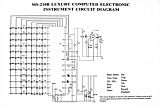
overview |

keyboard matrix & pinout |

wiring |
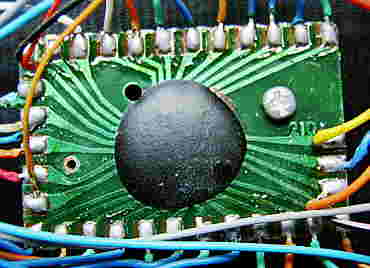 |
In the schematics the CPU is named "FE-2" and the depicted circle (between
B/C and VIB pin) on it stands for the empty hole in the COB PCB that is
closest to the blob. It may be that this was originally meant to mark pin
1, but I consider counting anticlockwise from the corner after the biggest
gap (with the screw between trace bundles) more logical as pin 1, thus
the pin labelled "210" is pin 32. The VSS pin 30 (ground 0V) is placed
here differently (skipping 2 pins, but pin order matches HT3421A
pad layout). The schematics shows a 2nd pin in its real place (where in
HT3421A MEMO would be), leading to the middle of the IC (labelled "DEMO",
which is likely misspelled "MEMO"; HT3421A datasheet claims that chip bottom
is VDD, i.e. positive supply voltage, so it can't be connected there).
I.e. in this COB module unfortunately the MEMO pin was omitted and internally
wired to VSS, so its sequencer is always recording. Also the auto-power-off
timer is still doing its job, despite by the missing BUSY pin (how stupid
is that?!) it can not turn off the amplifier. So there still is a slide
switch and you additionally always have to press 'computer start' (aka
'on/off' button) to make the thing work. Possibly this chip was a pirated
version of "Holtek HT3421A", but the manufacturer did not know how to handle
APO properly and so removed all pins he did not understand. |
The 12 demos of this instrument are:
-
American Patrol
-
It Is A Small World
-
Old Macdonald Had A Farm
-
Yankee Doodle
-
This Old Man
-
Wooden Heart
-
Happy Birthday To You
-
Silent Night
-
Home Sweet Home
-
Symphony No. 9
-
Mary Had A Little Lamb
-
Twinkle Twinkle Little Star
A direct predecessor of this instrument was the Yongmei
MS-110A. Another monophonic Hing Hon EK-001 variant with 12 demos
was the Playskool - Kid Keys PS-635.
| removal
of these screws voids warranty... |
|
|
 |

|
|
| |
back
|
|






 My
Yongmei MS-210B arrived with its right end smashed to about 30 small debris
because the vendor didn't pad the case end properly but despite warning
only wrapped the original box in a thin layer of bubble wrap, which is
in no way sufficient. A year before that I had ordered a MS-110A
with identical case, that was shattered similarly, but when I reported
that damage in a Deutsche Post post office, the spirt- nosed post
office clerk smeared a few words across the damage report form (instead
of filling out the entries), intentionally smashed the remains of the wrapped
keyboard with a huge 20kg parcel on a trolley and sent it back to the sender
despite I explicitly requested to sent it back to me after damage analysis.
I never saw that keyboard again nor I got any money back. Thus I did not
report the incident with the shattered MS-210B to a post office again,
but puzzled it together with a lot of superglue, which took a full day.
My
Yongmei MS-210B arrived with its right end smashed to about 30 small debris
because the vendor didn't pad the case end properly but despite warning
only wrapped the original box in a thin layer of bubble wrap, which is
in no way sufficient. A year before that I had ordered a MS-110A
with identical case, that was shattered similarly, but when I reported
that damage in a Deutsche Post post office, the spirt- nosed post
office clerk smeared a few words across the damage report form (instead
of filling out the entries), intentionally smashed the remains of the wrapped
keyboard with a huge 20kg parcel on a trolley and sent it back to the sender
despite I explicitly requested to sent it back to me after damage analysis.
I never saw that keyboard again nor I got any money back. Thus I did not
report the incident with the shattered MS-210B to a post office again,
but puzzled it together with a lot of superglue, which took a full day.
